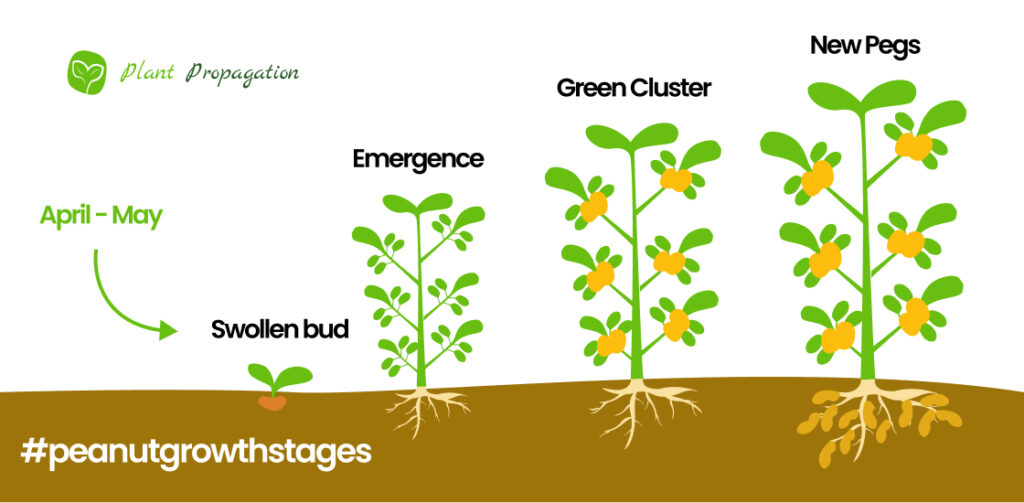
Peanuts, also knows as Arachis hypogaea, belong to the legume family and undergo a unique process called geocarpy, where their flowers are pollinated above ground, but the developing pods are pushed into the soil for maturation. This growth cycle makes peanuts remarkable and different from most other plants.
Notably, peanuts are a valuable source of protein, healthy fats, and various essential nutrients, making them a significant crop both historically and nutritionally.
What do you need to grow peanuts?
For peanuts to grow, it is important to create the right environment where they will live. This includes what kind of soil to plant it in, how much water, how much and what kind of light it should get. Without the right factors, the plant will die shortly.
How much water do peanuts need to grow?
Peanuts require about 28 inches of water to grow, so it can be said that this plant is water-intensive. It is important to keep watering regularly until the first flowering, as this is when the plant enters its reproductive state and produces.
How often do you need to water peanut?
Since peanuts are water-intensive, they need to be watered up to four times a week. The general rule is to water when the soil is dry and water until it is visibly damp.
How much light does the peanut plant need to grow?
Peanuts are extremely light-hungry. The plant needs direct sunlight for at least 8 hours a day. The plant is intolerant of not getting full sunlight, so this is something to watch out for.
What soil does peanut need to grow?
The peanut loves sandy, well-drain soil. It will live in any soil, but you must ensure that the soil is loose. Slightly acidic soil is suitable for peanuts. The pH of the soil should not exceed 6.5 and should not be less than 6.0.
How to grow peanuts?
Homegrown peanuts allow you to savor the freshness and flavor that store-bought options often lack. Witnessing the entire growth process, from planting to harvesting, is a gratifying experience that deepens your understanding of the food production cycle. And the best part about it? It is not difficult at all! Follow the steps below to start planting you peanut.
- Loosen the soil to a depth of at least 6 inches and amend it with organic matter to improve drainage and fertility.
- Choose high-quality peanut seeds from a reputable source or consider saving seeds from previous harvests.
- Plant seeds about 1.5 to 2 inches deep, with a spacing of 6 to 8 inches apart in rows that are around 24 to 36 inches apart.
- Keep the soil consistently moist but not waterlogged during the germination period. Once the plants are established, gradually reduce the frequency of watering.
- As the plants grow, they will develop delicate yellow flowers that will eventually produce the peanut pods. Monitor for pests and diseases, and provide support for the developing plants if needed.
What are the growing stages of peanut?
Follow these stages of growing peanut as you can ensure that your plants are healthy.
- Swollen bud stage: As winter fades, around April to May, when soil temperatures hit 65-70°F, it’s time to plant the seeds. About 2 inches deep, spaced 1-2 inches apart in harvest-friendly rows.
- Emergence: Roughly 10 days later, witness the soil crack as seeds sprout, revealing tender shoots.
- Green cluster: After around 40 days, when plants stand at 18 inches, blooms burst forth, a celebration of life.
- New Pegs: Flowers transform into “pegs,” diving into the soil, then curving to shape pods. This process, spanning four to five months, yields up to 40 pods per plant.
- Harvest: At 140-150 days, the entire plant is lifted, roots and all, revealing the hidden underground treasure.

When to plant peanut?
The timing plays a crucial role in successful growth. The best time to plant varies depending on your region’s climate. In warmer regions, peanuts can be planted in spring, while cooler regions may require a later spring or early summer planting. It’s essential to consider the frost-free date and ensure the soil has warmed adequately for optimal germination.
How long does it take to grow peanuts?
Depending on the variety and the conditions, it is going to take about 4-5 months to have the peanuts ready for harvest. How can you tell? It is time when the foliage turns yellow and the pods are mature. Carefully dig up the plants, shake off excess soil, and allow the pods to dry in a warm, well-ventilated area.
Where to plant peanut plants?
Choosing the right location for peanut cultivation is also vital. Peanuts thrive in well-draining, sandy loam soil with a pH range of 5.8 to 6.2. Ensure the planting site receives full sunlight for most of the day, as this is essential for robust growth and pod development. Be mindful of potential challenges such as diseases and pests, and consider crop rotation to prevent issues.
